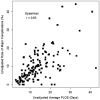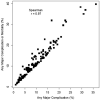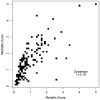An empirically based tool for analyzing morbidity associated with operations for congenital heart disease
- PMID: 22835225
- PMCID: PMC3824389
- DOI: 10.1016/j.jtcvs.2012.06.029
An empirically based tool for analyzing morbidity associated with operations for congenital heart disease
Abstract
Objective: Congenital heart surgery outcomes analysis requires reliable methods of estimating the risk of adverse outcomes. Contemporary methods focus primarily on mortality or rely on expert opinion to estimate morbidity associated with different procedures. We created an objective, empirically based index that reflects statistically estimated risk of morbidity by procedure.
Methods: Morbidity risk was estimated using data from 62,851 operations in the Society of Thoracic Surgeons Congenital Heart Surgery Database (2002-2008). Model-based estimates with 95% Bayesian credible intervals were calculated for each procedure's average risk of major complications and average postoperative length of stay. These 2 measures were combined into a composite morbidity score. A total of 140 procedures were assigned scores ranging from 0.1 to 5.0 and sorted into 5 relatively homogeneous categories.
Results: Model-estimated risk of major complications ranged from 1.0% for simple procedures to 38.2% for truncus arteriosus with interrupted aortic arch repair. Procedure-specific estimates of average postoperative length of stay ranged from 2.9 days for simple procedures to 42.6 days for a combined atrial switch and Rastelli operation. Spearman rank correlation between raw rates of major complication and average postoperative length of stay was 0.82 in procedures with n greater than 200. Rate of major complications ranged from 3.2% in category 1 to 30.0% in category 5. Aggregate average postoperative length of stay ranged from 6.3 days in category 1 to 34.0 days in category 5.
Conclusions: Complication rates and postoperative length of stay provide related but not redundant information about morbidity. The Morbidity Scores and Categories provide an objective assessment of risk associated with operations for congenital heart disease, which should facilitate comparison of outcomes across cohorts with differing case mixes.
Copyright © 2013 The American Association for Thoracic Surgery. Published by Mosby, Inc. All rights reserved.
Figures




Similar articles
-
An empirically based tool for analyzing mortality associated with congenital heart surgery.J Thorac Cardiovasc Surg. 2009 Nov;138(5):1139-53. doi: 10.1016/j.jtcvs.2009.03.071. J Thorac Cardiovasc Surg. 2009. PMID: 19837218
-
Updating an Empirically Based Tool for Analyzing Congenital Heart Surgery Mortality.World J Pediatr Congenit Heart Surg. 2021 Mar;12(2):246-281. doi: 10.1177/2150135121991528. World J Pediatr Congenit Heart Surg. 2021. PMID: 33683997
-
Variation in outcomes for risk-stratified pediatric cardiac surgical operations: an analysis of the STS Congenital Heart Surgery Database.Ann Thorac Surg. 2012 Aug;94(2):564-71; discussion 571-2. doi: 10.1016/j.athoracsur.2012.01.105. Epub 2012 Jun 15. Ann Thorac Surg. 2012. PMID: 22704799 Free PMC article.
-
Sutureless Aortic Valve Replacement for Treatment of Severe Aortic Stenosis: A Single Technology Assessment of Perceval Sutureless Aortic Valve [Internet].Oslo, Norway: Knowledge Centre for the Health Services at The Norwegian Institute of Public Health (NIPH); 2017 Aug 25. Report from the Norwegian Institute of Public Health No. 2017-01. Oslo, Norway: Knowledge Centre for the Health Services at The Norwegian Institute of Public Health (NIPH); 2017 Aug 25. Report from the Norwegian Institute of Public Health No. 2017-01. PMID: 29553663 Free Books & Documents. Review.
-
Stratification of complexity: the Risk Adjustment for Congenital Heart Surgery-1 method and the Aristotle Complexity Score--past, present, and future.Cardiol Young. 2008 Dec;18 Suppl 2:163-8. doi: 10.1017/S1047951108002904. Cardiol Young. 2008. PMID: 19063787 Review.
Cited by
-
Prophylactic corticosteroids for infants undergoing cardiac surgery with cardiopulmonary bypass: a systematic review and meta-analysis of randomized controlled trials.BMC Anesthesiol. 2024 Oct 25;24(1):385. doi: 10.1186/s12871-024-02772-7. BMC Anesthesiol. 2024. PMID: 39455954 Free PMC article.
-
Soluble transferrin receptor is associated with red blood cell transfusion in infant cardiac surgery.Transl Pediatr. 2024 Sep 30;13(9):1529-1539. doi: 10.21037/tp-24-132. Epub 2024 Sep 11. Transl Pediatr. 2024. PMID: 39399707 Free PMC article.
-
Early ascertainment of genetic diagnoses clarifies impact on medium-term survival following neonatal congenital heart surgery.J Clin Invest. 2024 Jul 30;134(18):e180098. doi: 10.1172/JCI180098. J Clin Invest. 2024. PMID: 39078715 Free PMC article. No abstract available.
-
Commentary on: Predictive value of NT-proBNP and hs-TnT for outcomes after pediatric congenital cardiac surgery.Int J Surg. 2024 Sep 1;110(9):5841-5842. doi: 10.1097/JS9.0000000000001610. Int J Surg. 2024. PMID: 38752500 Free PMC article. No abstract available.
-
Surgical pulmonary arterioplasty at bidirectional cavopulmonary anastomosis leads to favorable pulmonary hemodynamics at final stage palliation.JTCVS Open. 2024 Feb 17;18:180-192. doi: 10.1016/j.xjon.2024.02.006. eCollection 2024 Apr. JTCVS Open. 2024. PMID: 38690435 Free PMC article.
References
-
- O’Brien SM, Clarke DR, Jacobs JP, Jacobs ML, Lacour-Gayet FG, Pizarro C, et al. An empirically based tool for analyzing mortality associated with congenital heart surgery. J Thorac Cardiovasc Surg. 2009;138:1139–53. - PubMed
-
- Mahle WT, Wernovsky G. Long-term developmental outcome of children with complex congenital heart disease. Clin Perinatol. 2001;28:235–47. - PubMed
-
- Jacobs ML, Jacobs JP, Franklin RCG, Mavroudis C, Lacour-Gayet F, Tchervenkov CI, et al. Databases for assessing the outcomes of the treatment of patients with congenital and paediatric cardiac disease–the perspective of cardiac surgery. Cardiol Young. 2008;18(Suppl 2):101–15. - PubMed
MeSH terms
Grants and funding
LinkOut - more resources
Full Text Sources
Other Literature Sources
Medical

